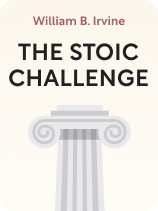

This article is an excerpt from the Shortform book guide to "The Stoic Challenge" by William B. Irvine. Shortform has the world's best summaries and analyses of books you should be reading.
Like this article? Sign up for a free trial here.
What did the Stoics believe about adversity? How did the Stoics handle challenges in life?
In general, the Stoics were pragmatists who focused on withstanding life’s challenges with resolve and resourcefulness. They believed that you should try to control only what’s within your power and let go of everything else.
Keep reading to learn more about the Stoics’ beliefs.
How the Stoics Handled Adversity
What did the Stoics believe? Though we might handle adversity poorly by default, author William B. Irvine argues that anyone can learn to navigate her troubles more effectively. You can begin to do so by understanding two Stoic insights:
- Most things are out of our control. Other people, the weather, society, the world’s governmental and economic systems, the natural world—no single person has power over these things.
- How we respond to the world is in our control. While we can’t stop storms, wars, or social disasters at work, we can control how we respond to these events.
So instead of reacting poorly when adversity comes along, a Stoic would choose to consciously respond—first, by using a mental technique to bypass and defuse their reactive emotions, and then by looking for ways to overcome the problem. This strategy served the main aim of a Stoic’s life, which, according to Irvine, was to create and maintain inner tranquility.
(Shortform note: Though Irvine asserts that the Stoics aimed for inner tranquility above all, this may not paint the full picture. Donald Robertson, another contemporary Stoic, argues that Irvine subtly reinterprets the central aim of Stoicism—switching it from a life of virtue to a life of equanimity or tranquility. In an age that emphasizes self-realization as the primary source of happiness, Irvine’s interpretation may make Stoicism more palatable. However, Robertson argues that this interpretation loses the essential spirit of Stoicism: its central argument that virtue is both the ends and the means of the good life. (Note that Irvine does acknowledge in A Guide to the Good Life that his Stoicism is not fully classical Stoicism.))
According to Irvine, the Stoics’ key mental technique was simply to reframe the problem. That is, upon encountering a problem or obstacle, a Stoic would choose to view it as an opportunity to practice his Stoic virtues—resilience, resolve, resourcefulness, courage, and good humor. Doing this would improve both his psychological and practical responses to adversity:
- Psychologically, he would maintain emotional equanimity (or resolve) by choosing to respond rather than react to the problem. He would aim to prevent the arising of negative emotions like anger, frustration, or cowardice.
- Practically, greater resolve would afford him a clear mind with which to solve the problem, demonstrating his resourcefulness.
(Shortform note: One reason reframing a problem might improve your psychological response is that reframing can help you notice and correct unhelpful automatic thoughts—things we think reactively, often without noticing. In Cognitive Behavior Therapy: Basics and Beyond, Judith S. Beck explains that automatic thoughts tend to drive our emotional responses, and habitually failing to correct negative automatic thoughts can lead to disorders such as anxiety and depression. Since reframing involves actively choosing how you think about a situation, it helps you notice these habitual thoughts so that you can decide not to reinforce them. In turn, this provides psychological relief by dissipating any painful emotional associations and uncovering limiting beliefs.)
After reframing a problem, Irvine says, a Stoic would look for a resourceful way to solve it. This boils down to using your clear mind to find creative solutions, though Irvine doesn’t say exactly how to do so.
(Shortform note: In Algorithms to Live By, Brian Christian and Tom Griffiths argue that we can derive many practical, creative problem-solving tools from computer science, since we, like computers, must make efficient decisions with limited time and energy. For example, the authors provide algorithms that can help you know when to settle on a good option, how to optimize your time and energy, and how to better estimate what might happen in the near future. Any one of these could become a handy rule of thumb that you combine with Irvine’s reframing strategy to more swiftly overcome obstacles.)
Shortform Example: Resolving Family Arguments
To get a feel for this strategy in action, imagine that you’ve gone to a friend’s house for the holidays. Her family has begun to gather, and you notice tensions among a few of the relatives. Over dinner, an argument breaks out—a disagreement over a hot political topic like gun control or the environment. You’ve started to feel stressed and uncomfortable when, suddenly, they ask for your take.
Your Stoic strategy kicks in: You breathe, reframe the situation as an opportunity to practice your Stoicism, and diffuse the arising of those stressful emotions. With a clearer mind, you can see that beyond the disagreement, there’s common ground to find. With those calmed emotions and a steady mind, you steer the conversation in that direction, drawing attention to some of the shared values that underlie their varied opinions.
The argument fizzles, and just like that, you’ve handled this challenge like a Stoic. You’ve maintained steady emotions, found a resourceful solution, and gotten a bit better at the habit of using this strategy in daily life.

———End of Preview———
Like what you just read? Read the rest of the world's best book summary and analysis of William B. Irvine's "The Stoic Challenge" at Shortform.
Here's what you'll find in our full The Stoic Challenge summary:
- How you can minimize suffering by reframing it
- How you can use the Stoics’ strategy in your everyday life
- Why you should take any good fortune in stride






